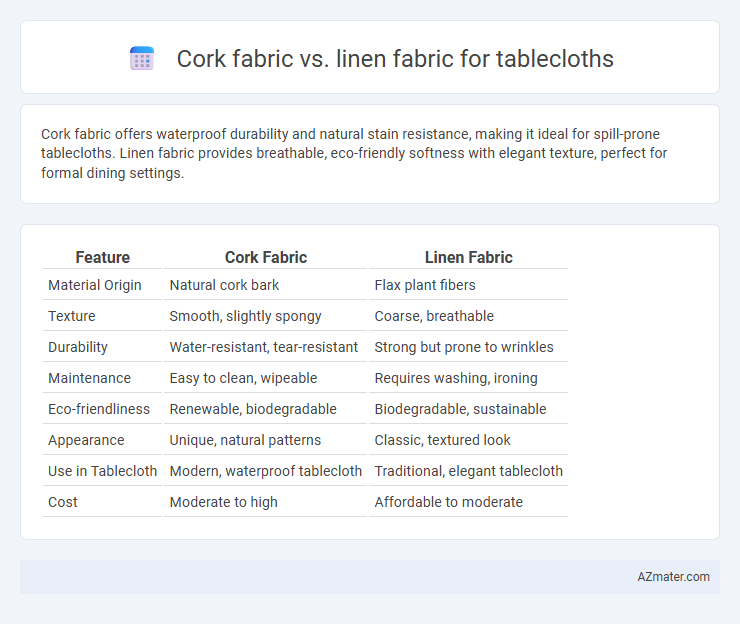Cork fabric offers waterproof durability and natural stain resistance, making it ideal for spill-prone tablecloths. Linen fabric provides breathable, eco-friendly softness with elegant texture, perfect for formal dining settings.
Table of Comparison
| Feature | Cork Fabric | Linen Fabric |
|---|---|---|
| Material Origin | Natural cork bark | Flax plant fibers |
| Texture | Smooth, slightly spongy | Coarse, breathable |
| Durability | Water-resistant, tear-resistant | Strong but prone to wrinkles |
| Maintenance | Easy to clean, wipeable | Requires washing, ironing |
| Eco-friendliness | Renewable, biodegradable | Biodegradable, sustainable |
| Appearance | Unique, natural patterns | Classic, textured look |
| Use in Tablecloth | Modern, waterproof tablecloth | Traditional, elegant tablecloth |
| Cost | Moderate to high | Affordable to moderate |
Introduction to Cork Fabric and Linen Fabric
Cork fabric, derived from the bark of cork oak trees, offers water resistance, durability, and a unique textured appearance ideal for tablecloths with a modern, eco-friendly touch. Linen fabric, made from flax fibers, is prized for its breathability, natural luster, and strong yet lightweight texture, providing a classic and elegant table setting. Both materials combine sustainability with distinct aesthetic qualities suitable for various dining environments.
Key Characteristics of Cork Fabric
Cork fabric, made from sustainable cork oak bark, offers water resistance and durability, making it ideal for tablecloths prone to spills and stains. Its natural anti-microbial properties prevent odors and bacteria buildup, ensuring hygienic use over time. Unlike linen, cork fabric is flexible yet sturdy, providing a unique texture and enhanced longevity for everyday dining settings.
Key Characteristics of Linen Fabric
Linen fabric is highly valued for its natural fiber composition, offering exceptional breathability and durability that make it ideal for tablecloths. Its smooth texture and moisture-wicking properties create a crisp, elegant appearance while resisting stains and wrinkles better than many other fabrics. Linen's eco-friendly nature and enhanced longevity through repeated washing further distinguish it from cork fabric in table settings.
Sustainability and Environmental Impact
Cork fabric for tablecloths offers a highly sustainable option due to its renewable harvesting from cork oak bark without tree felling, promoting forest conservation and carbon sequestration. Linen fabric, derived from flax plants, is biodegradable and requires less water and pesticides compared to cotton, but its cultivation can still impact soil health if not managed properly. Both materials present eco-friendly alternatives with cork providing durability and water resistance, while linen offers natural breathability and compostability, making each suitable for sustainable home textiles depending on specific environmental priorities.
Tablecloth Appearance and Texture Comparison
Cork fabric offers a unique, natural appearance with a slightly glossy, smooth surface that enhances modern tablecloth aesthetics, while linen fabric provides a classic, matte finish with visible weave patterns that evoke rustic elegance. The texture of cork fabric is firm yet flexible, resistant to wrinkles and stains, making it ideal for easy maintenance, whereas linen fabric features a soft, breathable texture that can become gently textured with use but requires careful handling to avoid creases. For tablecloths, cork fabric delivers a contemporary look with durability, whereas linen emphasizes timeless beauty and a tactile, organic feel.
Durability and Longevity
Cork fabric offers superior durability for tablecloths due to its natural resistance to water, stains, and wear, making it ideal for long-term use in busy dining settings. Linen fabric, while elegant and breathable, tends to show wear quicker with frequent washing and exposure to spills, requiring careful maintenance to extend its longevity. Choosing cork fabric ensures a robust, low-maintenance table covering, whereas linen provides a classic aesthetic with moderate durability.
Stain Resistance and Cleanliness
Cork fabric offers superior stain resistance compared to linen fabric due to its natural waterproof and antimicrobial properties, making it easier to clean and maintain for tablecloth use. Linen fabric, while breathable and elegant, is more prone to absorbing spills and stains, requiring frequent washing and careful stain treatment. Cork fabric's durability and non-porous surface ensure long-lasting cleanliness, ideal for high-traffic dining areas.
Comfort and Feel on the Table
Cork fabric offers a smooth, soft texture with a natural, matte finish that provides a warm and comfortable feel on the table, while being resistant to spills and stains. Linen fabric has a crisp, lightweight weave that feels cool and breathable, lending an elegant and airy touch to table settings but can wrinkle easily. Both materials enhance table comfort, with cork excelling in durability and cushioning, whereas linen offers a refined tactile experience ideal for formal occasions.
Cost Analysis: Cork vs Linen Tablecloths
Cork tablecloths generally have a higher initial cost compared to linen due to the unique harvesting and processing techniques of cork material. Linen tablecloths offer a more affordable price point, benefiting from widespread availability and traditional manufacturing methods. Long-term durability and ease of maintenance can impact overall value, with cork often providing superior stain resistance that may reduce replacement frequency.
Final Verdict: Which Tablecloth Fabric is Better?
Cork fabric offers superior water resistance and durability, making it ideal for long-lasting, low-maintenance tablecloths that withstand spills and stains. Linen fabric provides a natural, breathable texture with a luxurious aesthetic but requires more care and is prone to wrinkles. For practical, everyday use, cork fabric is better suited, while linen excels in formal settings where appearance is prioritized over ease of maintenance.

Infographic: Cork fabric vs Linen fabric for Tablecloth
 azmater.com
azmater.com